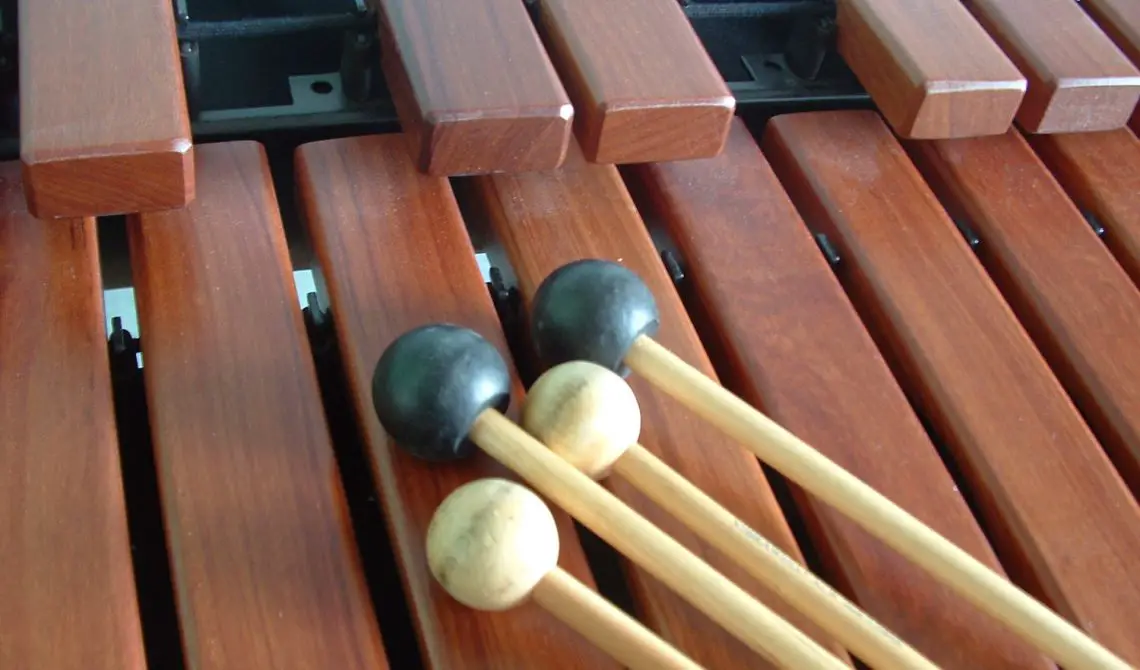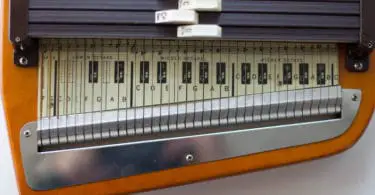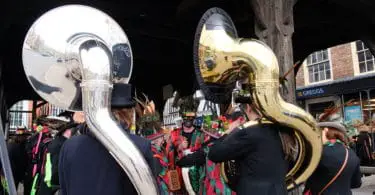So, you’re looking for a xylophone. Come closer my friend, we have important things to discuss. To say there are a lot of xylophones out there is an understatement.
If you’re serious about this venture, then I want to help. I’m going to teach you the basics of xylophone selection, and then I’m going to tell you about some of the best options. What you want will depend on what kind of music you’re playing.
You’ll be asking why you should trust me. As an excuse to talk about myself for a minute, I’ll tell you I’m a classically trained percussionist, and I’ve spent years playing professionally on a range of stages
I’ve performed in concert halls, on marching fields and in recording studios, and of all of the percussion I’ve played, mallet keyboards have always been my favorite. Still, I want this to be more than my personal guide, so I tempered my experience with research.
I have played more than a hundred different models and styles of xylophones to see which is best. I weighed my experience with popular and professional opinions, and now I’m presenting the results of that combined effort to you here.
Whether you need the exceptional performance of the Adams Alpha or a great starter like the Musser M66, this guide should get you well on your way to owning the perfect xylophone.
-
 Check on eBay
Check on eBayWith full resonators instead of partials that can cut weight at the cost of sound quality is actually impressive 2.5-octave, featuring Kelon bars that mesh beautifully with traditional marches. Weighing in at a scant 33 lbs., it has a full set of resonators and includes the harness.
-
 Check on Musician's Friend Check on eBay
Check on Musician's Friend Check on eBayA great value pick that produces an excellent outdoor sound
-
 $539.99Check on Amazon Check on Musician's Friend
$539.99Check on Amazon Check on Musician's FriendSounds very good, and the tuning is more than sufficient for learning proper ear training and fundamentals.
06/28/2025 10:07 pm GMT -
-
The Best Xylophones
There isn’t a single xylophone that reigns supreme over the competition. Instead, there are leaders in a number of categories, so I’ll be breaking the list accordingly. I do, however, have an absolute favorite, and I’ll be saving it for last.
Marching Xylophones
I picked two marching xylophones for the list. One is my top pick for the pit, and the other is the best on a harness.
Adams Solist 3.5 Octave Zelon
A great value pick that produces an excellent outdoor sound
No, you didn’t read that wrong. Adams spells it Solist instead of soloist. I’ve stopped asking why. With that out of the way, this is a great xylophone for a number of applications.

Credit: Steve Weiss Music, Inc
I’m listing it for use in the pit, but it’s just as suited for work in a school. Made from Zelon (Adam’s own variant on Kelon), it produces an excellent outdoor sound. It can cut through the big sounds of a full marching band and carry to the upper bleachers of the biggest stadiums.
The Zelon bars are extremely tough, making this xylophone as close as possible to impervious to weather. It’s also on an Adams frame, so it can withstand outdoor abuse, and it travels well with the band.
The best part of the deal is that it’s a mid-tier priced xylophone, making it a great value pick.
Musser M66
With full resonators instead of partials that can cut weight at the cost of sound quality is actually impressive 2.5-octave, featuring Kelon bars that mesh beautifully with traditional marches. Weighing in at a scant 33 lbs., it has a full set of resonators and includes the harness.

Credit: Musician’s Friend
If you need a xylophone on a harness that can march down the street or on the field, the M66 is the way to go. This 2.5-octave instrument features Kelon bars that mesh beautifully with traditional marches.
Weighing in at a scant 33 lbs., it has a full set of resonators and includes the harness in the package. Ok. If I’m being honest, 33 lbs. is a hefty weight to carry around, but it’s actually light for a 2.5-octave xylophone.
The fact that it has full resonators instead of partials that can cut weight at the cost of sound quality is actually impressive, and it’s a big part of why the M66 is the best.
It’ll set you back somewhere between $1300 and $1400, which is a steal considering the quality.
For Beginners
Let’s be real for a minute. A first-time xylophone player has no need for expensive bars, extended range and extraordinary sound quality.
You want an instrument that can take a little abuse, and you could stand to save a little money. With those thoughts in mind, I have no trouble recommending a clear favorite.
Stagg 37-Key
Sounds very good, and the tuning is more than sufficient for learning proper ear training and fundamentals.
Stagg set the bar for beginner’s xylophones with this baby. At 37 keys, there’s plenty of range to learn your scales and arpeggios, but it’s still small enough to save a little money.
The price tag starts low, dirt cheap in fact for something that can actually handle performances, and this baby can.

Credit: EMD MUSIC SA
The Padauk bars sound good, and the tuning is more than sufficient for learning proper ear training and fundamentals. This is easily my top choice.
Lyons 25-Note
More of a glockenspiel than a xylophone, better for kids or young musicians.
There is another market for xylophones that stirs mixed feelings. On one hand, my inner snob doesn’t want to talk about children’s xylophones. On the other, I absolutely advocate teaching music to children at a young age.
So, with perhaps a little bit of grudge, I am recommending the Lyons 25-note. Technically, this is more of a glockenspiel than a xylophone (sorry, a little bit of snobbiness had to slip out somewhere), but if you want to teach toddlers or young children the basics of music, this really is the best option out there.
With 25 notes, there’s enough range to learn the layout of the keyboard, and the metal bars are very tough.
The keys are labeled to help kids learn the notes, and it sits happily in its carrying case, so it can go with you wherever and whenever it is needed. With such a low price, t’s a value that you just can’t beat.
Concert Xylophones
At long last, I get to write my love letter. As a concert percussionist with more than 20 years of performance experience, this is my ultimate passion.
There are a number of amazing xylophones that have full-bodied sound and ring true throughout concert halls. There is one that stands out to me, and it is made by Adams.
Adams Alpha

Credit: Adams Musical Instruments
The Alpha was designed by people who share every drop of my passion. You can see it in the aesthetic design that was developed with engineers and architects from multiple fields.
The flowing resonators look as great as they sound. As you might expect from a top-shelf instrument such as this, the bars are made from perfectly aged Honduran Rosewood, and they are of the finest quality.
The tuning is masterful, perfect by generations of expertise and further developed through unique engineering methods. I would feel ashamed to admit that I do not own an Alpha xylophone, but my personal marimba is an Alpha, and I love it dearly. (Her name is Marie. Yes. Marie tha Marimba. You can stop judging now.)
I can’t rave enough about the Alpha series. It’s one drawback is the price. This is professional-grade equipment, and it will not come cheap. It’s worth every penny.
Ingredients for the Best Xylophone
Before we get into which xylophones are the best, it will probably help to know why they are so good. For that, we need to learn a little more about the construction of a xylophone.
There are four primary components to consider when comparing xylophones. They are material, frame, range and tuning. Please, allow me to get into the details.
Material
A search for the perfect xylophone always starts with the same question: what material makes the best keys? The answer to this question depends on your needs. Traditionally, xylophones are made from aged rosewood, and the highest quality usually stems from Honduras.
While shopping around, you’ll see Honduran Rosewood mentioned as a point of pride. While this is the ultimate material for filling a concert hall with the best possible sound, it isn’t always the way to go.
If you’re planning to play outside, rosewood sound will fail to carry, and it is extremely vulnerable to weather. In such cases, you’ll find synthetic options to be superior.
There are a few on the market, but the most common is Kelon. It’s been around for ages, and it is extremely durable, making it a great material for schools or outdoor ensembles that will put a xylophone through a little abuse.
Kelon has a few variants, and the most popular of those is acoustalon. The differences between the variants are pretty subtle, but the general rule is that traditional Kelon gets the most reverberation, which isn’t always ideal for a xylophone. Ultimately, there isn’t one synthetic that is universally the best. It mostly boils down to picking the one that fits your sound preference and budget.
Ultimately, there isn’t one synthetic that is universally the best. It mostly boils down to picking the one that fits your sound preference and budget.
There is a third important option for key materials: Padouk wood. Padauk has risen in popularity in the last few decades, and it’s a staple.
For more resonant instruments, rosewood is typically preferable to Padouk, but since xylophones specialize in staccato, the harsher tones of Padouk can accomplish unique sounds that are worth considering.
Padauk is a real wood, so it still isn’t the best option for outdoor work, but it is an often cheaper alternative to rosewood that doesn’t sacrifice sound quality.
Frame
The key material will be the biggest factor in determining how your xylophone performs, but the frame is almost as important. Frame designs are vast and diverse, and they affect every aspect of playing.
Frames can impact resonance and sound design, and they definitely control the durability and portability of a xylophone. Choosing the right frame is often a matter of weighing these three options against each other.
A xylophone that stays in one place can sacrifice mobility for a more resonant design, whereas travelling performers will probably consider ease of mobility and toughness to be more important.
When it comes to resonant frames, Musser wrote the book on this, and they still dominate the market. Their traditional frames push the limits of sound, but they do come at a price.
The frames are notoriously frustrating to disassemble and reassemble, and they don’t handle travel as well as many alternatives. If you want toughness and mobility, there are plenty of good options, but I favor the Adams frame design.
They can be deconstructed to fit your transportation needs, and after almost 20 years of abusing my Adams marimba, the frame hasn’t even shown a single scratch.
I’ll come back to this point in a few of my recommendations, but the general rule is that xylophones designed for portability will be marketed that way, and they are usually reliable.
Range
I almost didn’t include this section because it is so simple, but I know some of you are new to this business, and I don’t want to overlook the basics. For a xylophone, range is a very simple animal.
The only notes you can hit are the ones that have keys for you to — hit. When you’re shopping, the size of the xylophone will be listed.
In general, three octaves is a little on the small side while four octaves is a hulking mammoth of a xylophone.
More range is generally considered better, but you have to pay for it. For most applications, even at professional quality, 3.5 octaves is the standard.
Tuning
The last thing to learn about xylophones is tuning. Veterans among you might already know this, but for the newcomers, xylophone tuning mostly comes in two variations: octave and quint.
Quint tuning is the traditional style that was made popular in the 20s. It’s great for penetrating through the sound of an ensemble for music that wants to accentuate and feature the unique xylophone sound.
Octave tuning is more popular for European styles, producing a comparatively mellow sound that creates great clarity. This is another of those cases where there isn’t a superior choice; you’re just picking the style that suits you.
If you want to know more about the tuning process, this is a great video that discusses how tuning works on marimba and xylophone bars:
As a recap, here’s my list of the best xylophones:
With full resonators instead of partials that can cut weight at the cost of sound quality is actually impressive 2.5-octave, featuring Kelon bars that mesh beautifully with traditional marches. Weighing in at a scant 33 lbs., it has a full set of resonators and includes the harness.
A great value pick that produces an excellent outdoor sound
Sounds very good, and the tuning is more than sufficient for learning proper ear training and fundamentals.
More of a glockenspiel than a xylophone, better for kids or young musicians.











Start the discussion at talk.hearthemusicplay.com